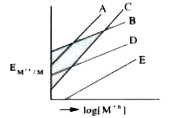The molar conductivities of H+andHCOO− ions at infinite dilution are 34.7 and 5.4 mSm2 mol−1 respectively. The molar conductivity of 0.25 M HCOOH is 4.0mSm2mol−1. Then pKa of formic acid is Solution in Telugu
3.6
4.2
4.8
1.8
The correct Answer is:A
α=∧M∧0M=434.6+5.4=4210=0.1,Ka=Cα2=0.025×(0.1)2=25×10−5
PKa=−log(25×10−5)=5−log52=5=2log5=5−2×0.7=5−1.4=3.6
Topper's Solved these Questions
- BOOK - AAKASH SERIESCHAPTER - ELECTROCHEMISTRY EXERCISE - PRACTICE SHEET -5 (LINKED COMPREHENSION TYPE QUESTIONS (PASSAGE-I))3videos
ELECTROCHEMISTRY
- BOOK - AAKASH SERIESCHAPTER - ELECTROCHEMISTRY EXERCISE - PRACTICE SHEET -5 (LINKED COMPREHENSION TYPE QUESTIONS (PASSAGE-II))3videos
ELECTROCHEMISTRY
- BOOK - AAKASH SERIESCHAPTER - ELECTROCHEMISTRY EXERCISE - PRACTICE SHEET -4 (INTEGER ANSWER TYPE QUESTIONS )6videos
ELECTROCHEMISTRY
- BOOK - AAKASH SERIESCHAPTER - DILUTE SOLUTIONSEXERCISE - EXERCISE - 1.255videos
DILUTE SOLUTIONS
- BOOK - AAKASH SERIESCHAPTER - ELEMENTS OF D - BLOCKEXERCISE - EXERCISE - 5.233videos
ELEMENTS OF D - BLOCK
Similar Questions
Nernst equation gives the variation of potential of an electrode based on activity of ions temperature and pressure. The equation is
E=E∘−2.303RTnFlogQ(or)E=E∘−0.0591nlogQ
E∘= Standard potential and 'Q' is the reaction quotient.
What is the reduction potential of a hydrogen electrode in an aqueous solution containing 0.1 M NH4OH,(Kb=10−5), ?01:40View SolutionFor metal electrodes show the variation in their reduction potential as shown.

Which is the most reactive metal ?02:13View SolutionDuring electrolysis of one mole or aq HCOOK . How many moles of H2 is formed overall ?
01:28View SolutionWhat are the factor on-which solubility depends on ?
02:35View SolutionGive some examples for the ions with pseudo inert gas electronic configuration.
01:40View SolutionThe molar conductivity of 0.05 M solution of weak acid is 16.6Omega^(-1)cm^(-2)mol^(-1). Its molar conductivity at infinite dilution is 390.7Omega^(-1)cm^(-2)mol^(-1) . The degree of dissociation of weak acid is
View SolutionThe molar conductivities at infinite dilution of KCl, KNO3 and AgNO3 at 298 K are 0.01499 mho m2mol−1, 0.01250 mho m2mol−1 and 0.01334 mho m2mol−1 respectively. What is the molar conductivity of AgCl at infinite dilution at this temperature ?
View SolutionMolar conductivity of a weak acid HA at infinite dilution is 345.8 cm^(2) mol^(-) calculate molar conductivity of 0.05 M HA solution
02:36View SolutionA weak monobasic acid is 5% dissociated in 0.01 mol dm−3 solution. The limiting molar conductivity at infinite dilution is 4.00×10−2ohm−1m2mol−1. Calculate the conductivity of a 0.05 mol dm−3 solution of the acid.
03:05View SolutionWhat will be the molar conductivity of Al 3+ ions at infinite dilution if molar conductivity of Al2(SO4)3 is 858 S cm2 mol−1 and ionic conductance of SO2−4 is 160 S cm2mol−1 at infinite dilution ?
05:57View SolutionThe molar conductivity of cation and anion of salt BA are 180 and 220 mhos cm2mol−1 respectively. The molar conductivity of salt BA at infinite dilution is -
01:55View SolutionBaCl2 के जलीय विलयन की अनंत तनुता पर मोलर चालकता ज्ञात कीजिए जबकि Ba2+ व Cl− आयन की आयनिक चालकताएँ क्रमश 127.03Scm2mol−1 एवं 76.34Scm2mol−1 है।
03:58View Solutionप्रबल विद्युत-अपघट्य किसे कहते है? BaCl2 के जलीय विलयन की अनंत तनुता पर मोलर चालकता ज्ञात कीजिए जबकि Ba2+ आयन व Cl− आयन की आयनिक चालकताएँ क्रमशः 127.30Scm2mol−1 एवं 76.35Scm2mol−1 है।
03:23View SolutionThe molar conductance at infinite dilution for electrolytes BA and CA are 140 and 120 ohm^(-1) Cm^(2) mol^(-1) respectively. If the molar conductance at infinite dilution of BX is 198 ohm^(-1) cm^(2) mol(-1), then then at infinite dilution, the molar conductance of is:
02:42View SolutionMolar conductance of 2 MH2A acid is 10 S cm2mol−1 Molar conductance of H2A at infinite dilution is 400 S cm2mol−1 which statement is/are correct?
View Solution

